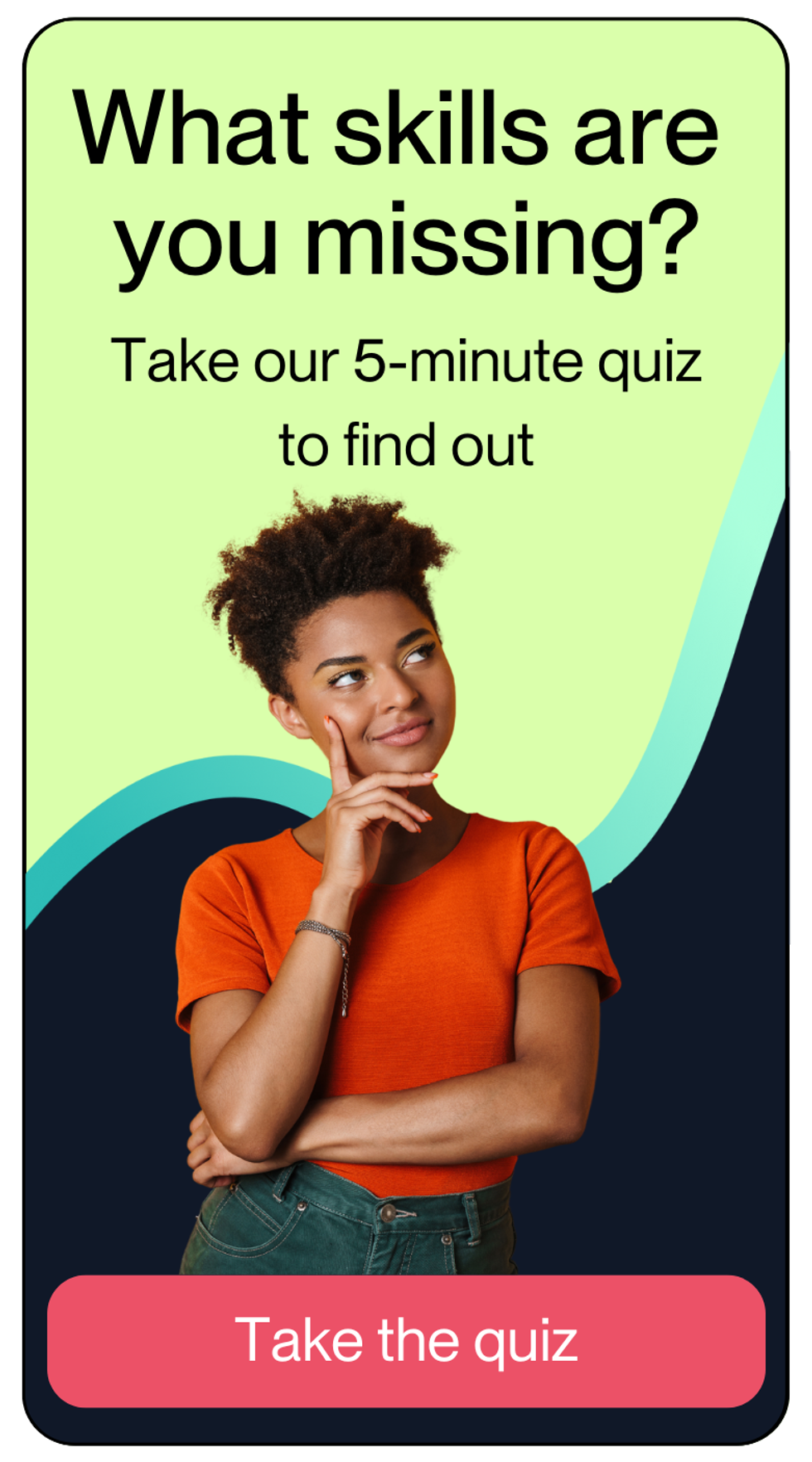Breaking news: we currently live in a skills-based job economy! We’ve been here for a while, and we have some good news if you’re feeling left-behind – the only thing you need is a skills-based resume.
Skills will continue to be in high-demand in 2025, so if you’re looking for a new job or planning to get back in the workforce, you’ve got great timing! You’re right at the start of a year that will favor the talented and the skilled over all else, even in this tough (at time of writing) job market.
Work experience, fancy job titles, and even well-known four-year degrees are now playing second banana to tangible skills with proven track records. (In fact, we’re so confident that skills are the thing to lead with that we can already tell you the top 10 skills that are about to blow up in 2025!)
If you’re in the market for your next big opportunity, it’s time to start telling your skills story with a skills-based resume…your traditional resume is past due for an update!
Why do I need to get a skills-based resume?
Before we tell you how, let’s start with why you need one to begin with! Basically, it’s trendy – buttttt that’s not a bad thing. Let’s look at four big workplace/resume trends that will keep putting skills in the limelight in 2025:
Focus on your core competencies
41% of recruiters are now working on a skills-based hiring model, which prioritizes competencies over educational qualifications and previous employers. This means that they are more likely to select a skills-based resume.
So what’s caused this shift? A shortage of labor.
2021 saw the ‘Great Resignation’ with over 44 million Americans quitting their jobs. This supply-demand imbalance has only widened in the last three years, so in this talent vacuum, companies have had to reconsider their recruitment methods to improve retention. Put simply, the narrative has shifted from ‘highly qualified’ to ‘highly skilled’ for the job.
Drive for diversity
When we focus on the skillset, we’re able to open the floor to a wider talent pool that can now make it to the top of the ladder regardless of where they come from. Skills-based hiring inherently clears the way for more inclusivity and provides an equitable space to marginalized groups too. Traditional hiring methods tend to favor candidates who are already at an advantage, considering divides like having access to better education or general career opportunities. Skills-based recruitment models do a good deal to eliminate that bias and make the selection process a meritocracy.
Freelancers are on the move!
The world has gone remote…at least when it comes to work. The pandemic forced a lot of businesses to make way for more flexible and contractual working models such as offsite and hybrid workers, consultants, and freelancers, and in most cases, it stuck. The workforce obviously loves these new choices, because it gives them a better chance at work-life balance and to control their work/life balance better and on their own terms.
It favors the employers too! Vendors and independent service providers help a business with some extra hands on deck, and oftentimes, when companies are short-staffed or occupied to their maximum capacity, they turn to highly skilled independent workers. PSST – the keyword here is “highly skilled.” The demand for contractual workers is definitely going to carry forward into the new year. In fact, Forbes predicts that searches for freelancers will grow by a whopping 65% in 2025. So, if you are looking to make that switch to becoming your own boss, a skills-based resume will absolutely come in handy!
AI screening
AI has been quite a game changer, and we’ll go ahead and say it: AI has disrupted and (largely) bettered just about every industry. Recruitment is no different. As of 2024, 80% of businesses are already using AI in their hiring protocol and in 2025, we expect AI to get better and faster at talent acquisition. With the current tech, AI is already able to prioritize the right candidate based on…you guessed it, their skills.
So, if in 2025, a job upgrade or career launch is on your resolutions, say ‘hello’ to a skills-based resume.
How to make a skills-based resume
1. Know your skills
Sounds obvious, but truly the first step to making your own skills-based resume is to know your own competencies. What are some skills you have learned, acquired, and used over the years? It doesn’t all have to be technical! In fact, people often overlook important soft skills like problem solving and communication. You definitely don’t want to miss out if you have one of these 10 good skills to put on your resume.
Take some time to fully understand and evaluate your own skills. We want to showcase all the relevant ones, and don’t worry if it feels like “too much,” we assure you, because employers want someone who’s versatile, adaptable, and quick to learn.
Check out SkillMeter, our quick personal skills audit, and find the skills you need to bring out in your resume!
2. Know the skills you need
The skills you have and the skills you need should ideally overlap. But we don’t always live in an ideal world, and tech is moving really, really fast. So, we don’t blame you if you feel you are under-skilled in this AI-driven world. The skills you needed to be a designer even five or six years ago might be outdated today, depending on your specialty.
So, if you are a graphic designer (for example), a good place to start will be understanding the skills you need to excel today, aka see what’s listed on the job descriptions you’re interested in. These are the skills that you need to learn and then highlight on your skills-based resume.
3. Know the skills the recruiter needs
This can be the tricky part! Two businesses on the lookout for a graphic designer may have very different requirements. For instance, one business might want someone with some UI/UX design skills, while the other may require video editing skills. So, when you make your skills-based resume, it is important to make it flexible and open to change as per the vacancy you are applying for.
The truth is there isn’t a ‘final’ resume anymore. To appeal to the employer and get past any recruiting ATS, you have to first appeal to the job description. Look for keywords in the description, and while tweaking your skills story for that job, aim to highlight and lead with those keywords.
4. Headline with skills
The point of a skills-based resume is that the showstopper is your skillset, so now it’s also the opener!
In your profile summary or resume headline, you don’t want to start with a generic “Senior programmer with 12 years of experience” title. You’ll want to bring out your skills right from the start. This is what it could look like:
A senior programmer well-versed in UI/UX design, Javascript, SQL, and Python. Proven track record in handling high-pressure deliverables, problem solving, ideation, and team leadership.
From here on, you can get into the details of how you have exhibited these aforementioned skills at work before.
5. Drive with results
Once you have stated a skill, back it up with tangible proof. Any form of data — stats, numbers, reports — that can establish your work at play helps.
This helps your employers understand your capabilities and also sets the right expectations for you at the job.
Instead of saying “worked in the sales department at XYZ”, you could say:
Improved sales by 75% for XYZ. Actively used problem-solving and communication skills to make the onboarding protocol easier and quicker.
Okay, now let’s put all of that to work!
Skills-based resume template
Here’s what your traditional resume might look like.
Work Experience:
- Creative Director, XYZ Company 2021–Present
- Copywriter, XYZ Company 2019–2021
As you can see, this format lays your work experience out in a chronological order while highlighting your rewards and recognition. Usually after that you’d put the other sections, where you branch into your education, then hobbies, and at the end your references.
Now, let us look at what a skills-based resume template looks like.
Profile: A seasoned marketer with expertise in tech products, outdoor as well as digital campaigns, online reputation management, and creative thinking. Skilled in creating ads that bring eyeballs as well as goodwill with positive problem solving and a customer-centric approach. Delivered 50+ campaigns successfully.
Professional Experience:
Creative Director, XYZ Company 2021–Present
- Spearheaded so-and-so campaign and drew 20% more direct sales.
- Awarded “Best Creative Ad in Tech” for the so-and-so campaign in 2023.
- Managing a team of over 20 creatives
- Increased team productivity by 15%.
Copywriter, XYZ Company 2019–2021
- Delivered 5 viral campaigns in the first year, creating greater brand recall
- Grew social media engagement over 60% in the first 2 months.
- 95% account retention rate, with marquee clients such as ABC, DEF…
We know you know now why the second one is better! Don’t just tell your title, tell your story.
And PowerToFly’s SkillMeter is the first step to creating your skill story - click to check your skills’ report in great detail!






